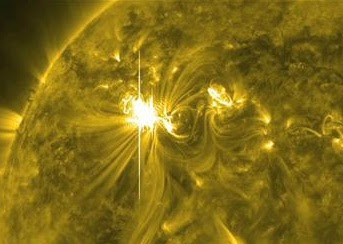An asteroid the size of a city block is set to fly by Earth June 14, and you may be able to watch it happen live.
The near-Earth asteroid 2012 LZ1, which astronomers think is about 1,650 feet wide, will come within 14 lunar distances of Earth Thursday evening. While there’s no danger of an impact on this pass, the huge space rock may come close enough to be caught on camera.
That’s what the team running the Slooh Space Camera thinks, anyway. The online skywatching service will train a telescope on the Canary Islands on 2012 LZ1 and stream the footage live, beginning at 8:00 p.m. EDT Thursday.
You can watch the asteroid flyby on Slooh’s website.
2012 LZ1 just popped onto astronomers’ radar this week. It was discovered on the night of June 10-11 by Rob McNaught and his colleagues, who were peering through the Uppsala Schmidt telescope at Siding Spring Observatory in Australia.
Researchers estimate that the space rock is between 1,000 and 2,300 feet wide. On Thursday evening, it will come within about 3.35 million miles of our planet, or roughly 14 times the distance between Earth and the moon.
Because of its size and proximity to Earth, 2012 LZ1 qualifies as a potentially hazardous asteroid. Near-Earth asteroids generally have to be at least 500 feet wide and come within 4.65 million miles of our planet to be classified as potentially hazardous.
2012 LZ1 is roughly the same size as asteroid 2005 YU55, which made a much-anticipated flyby of Earth last November. But 2005 YU55 gave our planet a much closer shave, coming within 202,000 miles (325,000 km) of us on the evening of Nov. 8. A space rock as big as 2005 YU55 hadn’t come so close to Earth since 1976, researchers said.
Astronomers have identified nearly 9,000 near-Earth asteroids, but they think many more are out there, waiting to be discovered.
The near-Earth asteroid 2012 LZ1, which astronomers think is about 1,650 feet wide, will come within 14 lunar distances of Earth Thursday evening. While there’s no danger of an impact on this pass, the huge space rock may come close enough to be caught on camera.
That’s what the team running the Slooh Space Camera thinks, anyway. The online skywatching service will train a telescope on the Canary Islands on 2012 LZ1 and stream the footage live, beginning at 8:00 p.m. EDT Thursday.
You can watch the asteroid flyby on Slooh’s website.
2012 LZ1 just popped onto astronomers’ radar this week. It was discovered on the night of June 10-11 by Rob McNaught and his colleagues, who were peering through the Uppsala Schmidt telescope at Siding Spring Observatory in Australia.
Researchers estimate that the space rock is between 1,000 and 2,300 feet wide. On Thursday evening, it will come within about 3.35 million miles of our planet, or roughly 14 times the distance between Earth and the moon.
Because of its size and proximity to Earth, 2012 LZ1 qualifies as a potentially hazardous asteroid. Near-Earth asteroids generally have to be at least 500 feet wide and come within 4.65 million miles of our planet to be classified as potentially hazardous.
2012 LZ1 is roughly the same size as asteroid 2005 YU55, which made a much-anticipated flyby of Earth last November. But 2005 YU55 gave our planet a much closer shave, coming within 202,000 miles (325,000 km) of us on the evening of Nov. 8. A space rock as big as 2005 YU55 hadn’t come so close to Earth since 1976, researchers said.
Astronomers have identified nearly 9,000 near-Earth asteroids, but they think many more are out there, waiting to be discovered.
News by Mashable
Read current news at http://bbc-cnn-worldnews.blogspot.com



